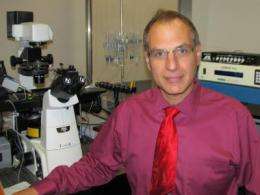Brake on nerve cell activity after seizures discovered: Gene expression initiates protective electrical response

Given that epilepsy impacts more than 2 million Americans, there is a pressing need for new therapies to prevent this disabling neurological disorder. New findings from the neuroscience laboratory of Mark S. Shapiro, Ph.D., at The University of Texas Health Science Center at San Antonio, published Dec. 20 in the high-impact scientific journal, Neuron, may provide hope.
"A large fraction of epilepsy sufferers cannot take drugs for their disorder or the existing drugs do not manage it," said Dr. Shapiro, professor of physiology in the School of Medicine. "As a result, many opt for surgery to remove the hippocampus, a part of the brain where memories are stored but also where seizures are often localized. The heart-wrenching choice is between their memories and the epilepsy."
Genes go into action
A major finding of the study is that selected genes get switched on during and after a seizure, sending swarms of signals to reduce uncontrolled firing of nerve cells. A medication that amplifies this response after a person's initial seizure could thus prevent recurrent seizures and the onset of devastating epilepsy.
Uncontrolled electrical activity by specialized electricity-producing proteins in the brain called "ion channels" triggers epileptic seizures. One in 10 people have a lifetime risk of suffering a seizure, which can occur for a variety of reasons including traumatic brain injury, stroke or drug overdoses.
A powerful brake
Although not all seizures lead to epilepsy, some trigger changes in the brain that heighten the risk of the disorder. Dr. Shapiro's research sheds light on why most isolated seizures do not lead to full-blown epilepsy, whereas others do. An ion channel called the "M-channel" acts as a powerful "brake" on hyper-excitability in the brain. Another organizational protein, called AKAP79, acting much like an air-traffic controller, calls in more M channels as part of neuroprotective response machinery.
"In addition to epilepsy, the findings have implications for relief from chronic pains, cardiovascular disease and recovery from mood disorders," he added.
Pharmacological therapy to enhance M-channel gene expression or AKAP79 function "could jump-start this neuroprotective mechanism to prevent a seizure from turning into epilepsy," Dr. Shapiro said. "Administering it right after a traumatic brain injury could be very effective."
It was not known that electrical activity could regulate M-channel genes, Dr. Shapiro said. Nor was it known that the AKAP79 organizer protein, which coordinates many aspects of M-channel function, could turn on their genes in a person's DNA. By increasing M-channel expression in the brain, uncontrolled electrical firing of nerve cells in the brain is sharply controlled.
Mouse experiments
The Shapiro lab team records electrical currents and performs imaging in living nerve cells to measure M-channel activity. This study included inducing seizures in healthy mice. After a seizure, gene expression of M-channels in the hippocampus increased more than 10-fold within 24 hours, Dr. Shapiro said. This protective effect was completely absent in mice lacking the mouse version of the AKAP79 gene.
"Because excessive firing of nerve cells is also involved in chronic pains, such as migraines, mood disorders and hypertension, increasing M-channel signals to reduce nerve-cell firing could also likely be effective in treating those conditions," Dr. Shapiro said.
This is only the second research paper from The University of Texas Health Science Center at San Antonio to be published by Neuron since 1996.













